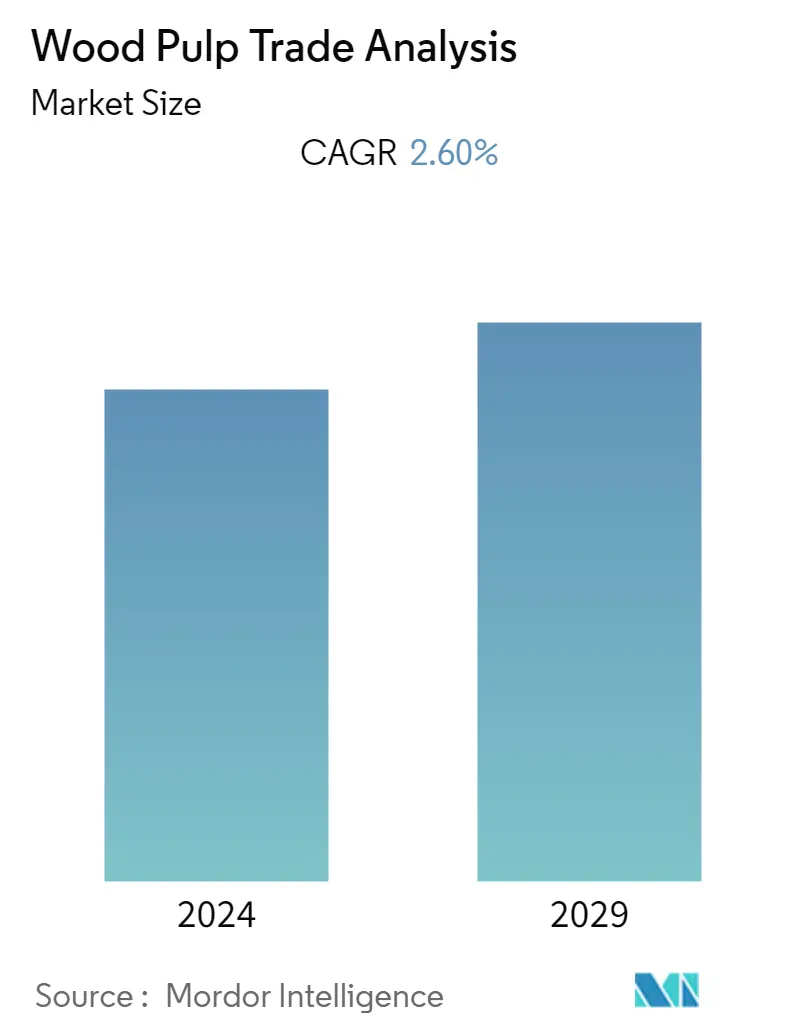Market Size of Wood Pulp Trade Analysis

| Study Period | 2019 - 2029 |
| Base Year For Estimation | 2023 |
| Forecast Data Period | 2024 - 2029 |
| CAGR | 2.60 % |
| Fastest Growing Market | Latin America |
| Largest Market | Asia-Pacific |
Major Players*Disclaimer: Major Players sorted in no particular order |
Wood Pulp Trade Analysis Market Analysis
The wood pulp market is expected to witness a CAGR of 2.6% during the forecast period.
- The pulp and paper industry involves many fields, such as forestry, agriculture, chemicals, biology, distribution, and transportation, thus occupying an important position in the global economy. Pulp is an intermediate chemically- or mechanically-processed fibrous material derived from wood or other plant fibers, whereas waste paper is a resource collected from previously discarded material. Both the wood pulp and waste paper contain varying amounts of cellulose fibers. According to the Food and Agriculture Organization (FAO), annual paper and paperboard production has increased by 6% since 2010.
- The pulp and paper industry comprises companies that use basic raw materials like wood to produce pulp, paper, paperboard, and various cellulose-based products. Annual global paper and board production and consumption capacities reached 419.7 million metric tons and 423.3 million metric tons, respectively, in 2019. North America and South America together account for more than half of the global production, followed by Europe and Asia-Pacific. Canada, the United States, and China are the top three wood pulp producers due to their improved technical knowledge and large forestry sectors.
- The major driving factors are the growing demands for the paper production industry due to the massive use of tissue paper in residences, kitchens, toilet facilities, restaurants, and healthcare facilities. Environmental concerns regarding the use of plastics and increased demand for packaging and industrial papers are some of the driving factors boosting the market's growth in the coming years.
Wood Pulp Trade Analysis Industry Segmentation
Wood pulp is processed into paper with the help of chemical compounds, such as caustic soda. Wood pulp is essentially used for the production of newsprint, cheap forms of paper, and hardboard.
The wood pulp market is segmented by geography (North America, Europe, Asia-Pacific, South America and Africa). The study covers export analysis (value and volume), import analysis (value and volume), and price trend analysis of wood pulp at a macro-level, in addition to the value chain.
The report offers market estimation and forecast in both value (USD million) and volume (metric ton).
| Geography | |||||||||
| |||||||||
| |||||||||
| |||||||||
| |||||||||
|
Wood Pulp Trade Analysis Size Summary
The wood pulp market is poised for steady growth, driven by its integral role in the global pulp and paper industry, which encompasses various sectors such as forestry, agriculture, and transportation. This industry is crucial for producing pulp, paper, and cellulose-based products, with significant contributions from North America, South America, Europe, and Asia-Pacific. The demand for paper, particularly in packaging and tissue products, is a major factor propelling market expansion. Environmental concerns over plastic use and the shift towards sustainable packaging solutions further bolster the market's growth prospects. The industry's evolution is also influenced by technological advancements and changing consumer behaviors, which are reshaping demand across sectors like hospitality, e-commerce, and personal hygiene.
Asia-Pacific stands as the largest market for wood pulp, with China and India playing pivotal roles in its growth. The region's demand for packaging-grade paper, driven by the FMCG and ready-to-eat food sectors, is a significant contributor to market dynamics. Despite challenges such as outdated production techniques and a reliance on imports for high-quality paper products, China is witnessing substantial investments in new wood pulp capacity, supported by favorable government policies. In India, initiatives like the Make in India policy aim to enhance domestic manufacturing capabilities, promoting technological advancements and packaging development. These factors collectively indicate a promising outlook for the wood pulp market during the forecast period.
Wood Pulp Trade Analysis Market Size - Table of Contents
-
1. MARKET DYNAMICS
-
1.1 Market Overview
-
1.2 Market Drivers
-
1.3 Market Restraints
-
1.4 Value Chain Analysis
-
-
2. MARKET SEGMENTATION
-
2.1 Geography
-
2.1.1 North America
-
2.1.1.1 United States
-
2.1.1.2 Canada
-
2.1.1.3 Mexico
-
-
2.1.2 Europe
-
2.1.2.1 Germany
-
2.1.2.2 United Kingdom
-
2.1.2.3 Italy
-
2.1.2.4 France
-
2.1.2.5 Netherlands
-
2.1.2.6 Sweden
-
2.1.2.7 Russia
-
-
2.1.3 Asia-Pacific
-
2.1.3.1 China
-
2.1.3.2 Australia
-
2.1.3.3 India
-
2.1.3.4 South Korea
-
2.1.3.5 Japan
-
2.1.3.6 Indonesia
-
-
2.1.4 South America
-
2.1.4.1 Brazil
-
2.1.4.2 Chile
-
-
2.1.5 Africa
-
2.1.5.1 South Africa
-
-
-
Wood Pulp Trade Analysis Market Size FAQs
What is the current Wood Pulp Market size?
The Wood Pulp Market is projected to register a CAGR of 2.60% during the forecast period (2024-2029)
Which is the fastest growing region in Wood Pulp Market?
Latin America is estimated to grow at the highest CAGR over the forecast period (2024-2029).

